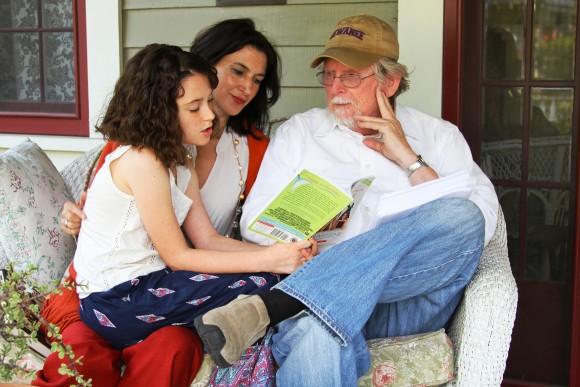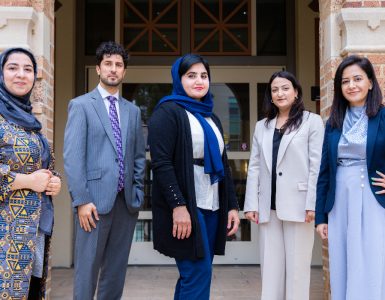“If they give you ruled paper, write the other way.” Juan Ramón Jiménez
Our 8-year-old daughter Lila will tell you she’s dyslexic, usually within a short time after meeting her. She’ll ask you if you’re dyslexic too, hoping you’ll say yes. She is almost proud of it. Proud because she knows that a lot of famous people she admires — like Walt Disney, Steven Spielberg and Keira Knightley — also are dyslexic. She’s almost proud because dyslexia is something she struggles with every day. Like many, I thought people with dyslexia flipped their letters around, and if pushed on the subject I might have said they were slow learners. I was wrong. Now, I believe dyslexia is a gift.

From left: Lila, Lisa Cupolo and Richard Bausch read together. Richard and Lisa are interested in finding news ways to address dyslexia.
Most dyslexic people possess average to above-average intelligence, and a disproportionate number of entrepreneurs, innovators, artists, Olympic athletes, scientists and actors are dyslexic. Interestingly, most of these people were unsuccessful or failed completely in traditional school settings. Dyslexics are “outside the box” thinkers. My husband, Richard Bausch, scraped by in high school, yet he is an award-winning writer and professor with a robust international reputation. He struggled with reading. To this day, he reads very slowly, yet he has read War and Peace five times. Dyslexia is genetic.
When Lila was born writer friends from around the country sent us gorgeous children’s books, enough to fill a small library. When she was a toddler we had tea parties at independent bookstore cafés and her room had a reading nook. We assumed she’d be an early reader, a passionate reader like us. She wasn’t.
In hindsight we did a lot of things wrong. We sent Lila to a private preschool in Memphis where local academics, doctors and businessmen sent their children. Lila was socially the most popular in the class, but the rigorous academics were difficult and even in kindergarten when she struggled, she felt stupid. When we moved to California three years ago, we thought Montessori would be a better fit for our imaginative, joyful, free-thinking girl. We thought she’d thrive and her creativity would shine. But at Montessori, in a class of 30 children, Lila used her smarts to hide her difficulty.
She had tutors three times a week. Teachers told us to find books that interested her, as if we hadn’t thought of that. Lila didn’t want to read books because the letters made no sense to her. It had nothing to do with her intellect or her phenomenal photographic memory. She hated school because no one understood her difference; other children made fun of her and she felt alone. She came home in tears. I was in tears. Not one person suggested she might be dyslexic.
At the end of first grade the principal told us Lila would do the state testing in the office so the questions could be read to her. “Where are the other kids taking the test?” I asked. “In the classroom,” I was told. My daughter couldn’t read the questions. I was devastated. My husband, who raised five other children, was troubled, but imagined it would resolve itself in time. After all, he was very late to read himself. “Lila must be dyslexic,” I said, finally.
The school shushed me. They said “Don’t say the word. It will go on her record for life.” If she’s dyslexic, I thought, I want it on her record for life. After much struggle for information, our friend, the Pulitzer Prize-winning writer Richard Ford, who is also dyslexic, suggested we find a school using a multisensory approach to learning. We enrolled Lila at The Prentice School in Tustin, for children with dyslexia. The visual and auditory approach has saved her confidence and fueled her joy of learning. She’s in third grade and still struggles but is now reading at grade level. The school has extensive art, music and science programs because dyslexic children are often gifted in these areas.
There is wide scientific proof that people with dyslexia have a different neurological makeup, easily identifiable through brain scans and simple diagnostic testing. In fact, up to 20 percent of people are dyslexic. Yet, there is a universal dogma that if a child reads early she’s smart, and of course this is indeed a marker of intelligence — but only if the child is not dyslexic.
I wish I’d known this. I want everyone to know it now. The hope is that society can get past measuring children’s success by the grades they get and the potential money they’ll make. Fortunately, it seems as though a new wave of teaching is emerging that honors all types of learning and thinking, and acknowledges that linear scholarship isn’t the only way to process experience.
Entrepreneur Richard Branson, of the Virgin empire, describes his dyslexia as his greatest strength. Being aware of the differences between people, and embracing the diversity, whether it be racial, socio-economic or neurological, is the key to a successful pedagogical community.





Add comment